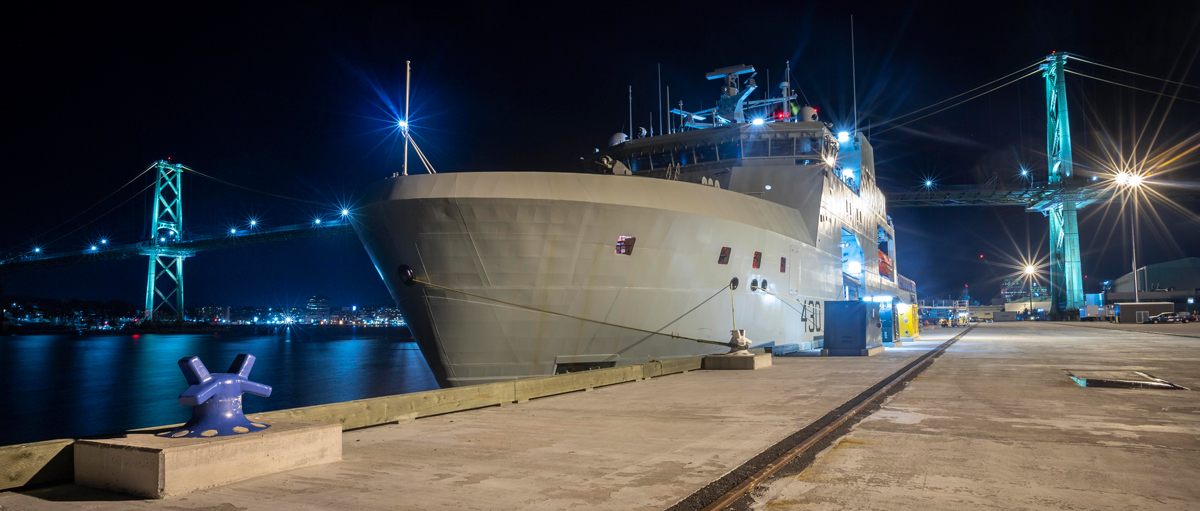Jackspeak: Port and Starboard
By Lookout Production on Nov 04, 2022 with Comments 0

HMCS HARRY DEWOLF sits alongside NJ Jetty, Halifax, Nova Scotia during Royal Canadian Navy Sea Trials on October 16, 2020.
The terms port and starboard are associated with a ship’s left and right sides when facing forward. While these two words are widely accepted as a part of modern nautical vernacular, their origin is lesser known. Newcomers often wonder why the two sides of a ship have such dissimilar names, not realizing this was done by design.
Historically, starboard is derived from the term ‘steerboard,’ which refers to a steering oar commonly housed on a vessel’s right side. Before rudders, a ship was steered using a long oar, or sweep oar, fitted on the right side of the ship near the stern. Vikings were known to use a steering oar, and it needs to be clarified why they chose the right side. There is a thought that because the vast majority of people are right-handed, the steering oar was designed for use by right-handed mariners. Regardless, a steering oar on the right became universal. Over time, steerboard became starboard, and it did so without any connection to celestial objects.
With a steering oar on the right side of the vessel, it was awkward to put a ship alongside a jetty on the right side, so the ship’s left side was used for this purpose. Typically, a plank was put across from ship to shore where personnel and goods could be transferred, and this plank was called a ladeboard or loadboard and later transformed into a larboard.
To avoid confusion between the terms larboard and starboard, larboard was eventually changed to port, which had been a common term since the 16th century. In 1844, the Royal Navy made it official by ordering that ‘port’ be used instead of ‘larboard’ about the left side of a ship. Since then, port and starboard have gained general acceptance as terms for a ship’s left and right sides.
Ships carried lights (lanterns) for many years and were known to show a white light whether underway or at anchor. There were no official rules about the use of lights until 1824, when two white lights were required to be shown in ships navigating the canals of the Netherlands and Belgium. In 1845, the Royal Navy ship HMS Comet conducted experiments at Spithead with a red light to mark the port side and a green light to mark the starboard. Soon, it was regulated that red and green running lights should be used on all ships to indicate port and starboard. Similar lights are also used in aviation, with a plane’s right wingtip displaying a green light and the left wingtip displaying a red light.
Green-to-green is a term that describes two vessels safely passing on their starboard and is derived from the green navigation lights on the ships’ starboard sides. Similarly, red-to-red describes two vessels safely passing on their port.
Red and green running lights are usually electrically powered, which might not be initially obvious to a junior sailor who is asked to fetch ‘green oil’ for the starboard running light. Many novices have fallen for this type of ruse, commonplace when a more senior sailor takes advantage of a recruit’s eagerness to fulfill orders and a proclivity to learn their duties. Admittedly, I still need to find that box of radar contacts I was once asked to locate.
You will find over 4,000 examples of Jackspeak in my book Jackspeak of the Royal Canadian Navy (2nd ed.).
The author of ‘Jackspeak of the Royal Canadian Navy’ and ‘Whiskey 601’, Mark Nelson developed a love of the Navy’s language and lifestyle over his 26-year career in the service. After retiring as a Chief Petty Officer Second Class, he now works as a Library Systems Specialist at Red River College Polytechnic in Winnipeg, Man.
Follow Mark on Twitter @4marknelson
Filed Under: Top Stories
About the Author:





